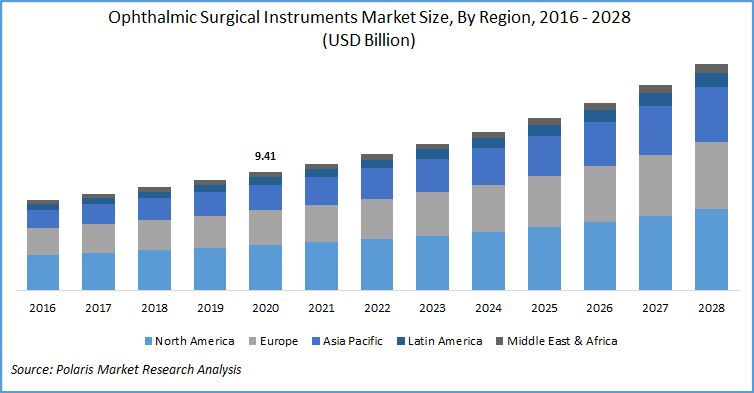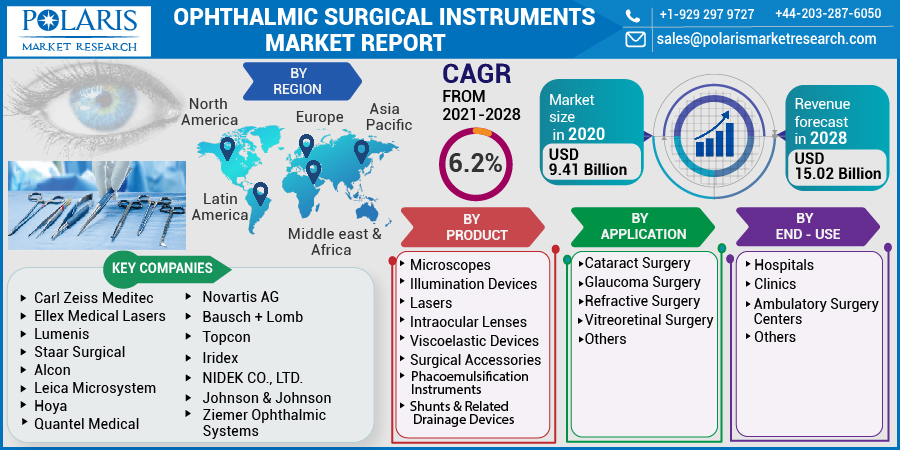
Ophthalmic Surgical Instruments Market Share, Size, Trends, Industry Analysis Report, By Product; By Application (Cataract Surgery, Glaucoma Surgery, Refractive Surgery, Vitreoretinal Surgery, Others); By End-Use (Hospitals, Clinics, Ambulatory Surgery Centers); By Regions; Segment Forecast, 2021 - 2028
- Published Date:Mar-2021
- Pages: 108
- Format: PDF
- Report ID: PM1834
- Base Year: 2020
- Historical Data: 2016 - 2019
Report Outlook
The global ophthalmic surgical instruments market size was valued at USD 9.41 billion in 2020 and is anticipated to grow at a CAGR of 6.2% during the forecast period. The demand for ophthalmic surgical instruments has increased over the years owing to the increasing geriatric population, and the growing need to provide enhanced patient experience during these surgeries.
Technological advancements and growing demand from developing countries are some factors fueling the market growth. Governments across the globe are introducing strict healthcare regulations, and support initiatives and schemes to promote the use of high-quality ophthalmic surgical instruments. However, high costs associated with these instruments, and low awareness in some developing nations hinder the market growth.
Ophthalmic surgical instruments include microscopes, lasers, intraocular lenses, shunts & related drainage devices, and viscoelastic devices, among others. Microscopes are used by surgeons for the acquisition of high contrast and detailed images of human eyes.
These microscopes offer views of microscopic elements of the human eye, which can be recorded and examined by other health professionals. Leading market players are integrating advanced technologies in ophthalmic microscopes to offer high-definition views along with enhanced clarity, depth, and contrast for improved efficiency and enhanced patient experience.
 Know more about this report: Request for sample pages
Know more about this report: Request for sample pages
Industry Dynamics
Growth Drivers
New product launches and acquisitions by leading players in the market coupled with technological advancements have increased the demand for ophthalmic surgical instruments across the globe. In December 2018, Carl Zeiss Meditec acquired IanTECH to expand its offerings in micro-interventional cataract surgery.
IanTECH specializes in the development of miLOOP Lens Fragmentation Device for micro-interventional cataract surgery platform. This device assists the surgeon in accomplishing full-thickness lens fragmentation. The acquisition is aimed at expanding the company’s offerings and strengthening its presence in the market.
The global market is fueled by rising healthcare expenditure and changing lifestyles. Consumers are spending long hours in front of laptops and mobile devices, increasing the risk of ophthalmic disorders. There has been an increasing occurrence of diseases such as diabetes, high blood pressure, and certain genetic disorders, supporting the growth of the market.
The demand for ophthalmic surgical instruments has increased from the Asia Pacific region owing to increasing awareness regarding eye defects, and growth in the healthcare sector. Global players are expanding into these countries to tap market potential, further boosting the market growth. Technological advancements and established R&D institutes in China and Japan further support the market growth.

Know more about this report: Request for sample pages
Ophthalmic Surgical Instruments Market Report Scope
The market is primarily segmented on the basis of product, application, end-use, and region.
|
By Product |
By Application |
By End-Use |
By Region |
|
|
|
|
Know more about this report: request for sample pages
Product Outlook
On the basis of product, the market is segmented into ophthalmic microscopes, illumination devices, phacoemulsification instruments, ophthalmic lasers, intraocular lenses, shunts & related drainage devices, ophthalmic viscoelastic devices, and ophthalmic surgical accessories. There has been a high demand for ophthalmic lasers for various surgeries such as glaucoma, cataract, refractive surgery, and vitreoretinal surgical devices. Ophthalmic lasers are widely used for the pain-free treatment of ocular diseases with enhanced safety, and accuracy.
Application Outlook
The application segment has been divided into cataract surgery, glaucoma surgery, refractive surgery, vitreoretinal surgery, and others. The cataract surgical instruments accounted for a major share of the global ophthalmic surgical instruments market. The increasing geriatric population, rising occurrence of diseases such as diabetes and hypertension, and growing obesity are some factors increasing the occurrence of cataracts. The increasing need to offer improved healthcare services coupled with increasing awareness among consumers supports the market growth.
End-Use Outlook
On the basis of end-use, the market is segmented for ophthalmic surgical instruments into hospitals, clinics, ambulatory surgical centers, and others. The hospital segment dominated the global ophthalmic surgical instruments market in 2020. The wide adoption of ophthalmic surgical instruments in hospitals is owing to factors such as advanced healthcare infrastructure, increasing geriatric population, and availability of advanced medical devices. The presence of experienced medical professionals and the emergence of hospitals in developing economies further boost the growth of this segment.
Geographic Overview
North America dominated the global ophthalmic surgical instruments market in 2020. Increasing occurrences of ocular diseases such as cataracts and glaucoma, growing research and development activities, and technological advancements are some factors attributed to the growth of this region.
The established healthcare infrastructure, rising geriatric population, and increasing investments in healthcare innovation drive the growth of this region. Changing lifestyles coupled with increasing cases of lifestyle-associated diseases such as diabetes have increased the demand for ophthalmic surgical instruments in the region.
Competitive Landscape
The leading players in the ophthalmic surgical instruments market include Carl Zeiss Meditec, Ellex Medical Lasers, Lumenis, Staar Surgical, Alcon, Leica Microsystem, Hoya, Quantel Medical, Novartis AG, Bausch + Lomb, Topcon, Iridex, Ziemer Ophthalmic Systems, NIDEK CO., LTD., and Johnson & Johnson.
These players are expanding their presence across various geographies and entering new markets in developing regions to expand their customer base and strengthen presence in the market. The companies are also introducing new innovative instruments in the market to cater to the growing consumer demands.
